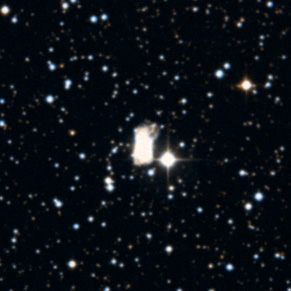 The
Cheeseburger Nebula (NGC 7026) at first appears as just another tiny
smudge of light, but in a large aperture instrument at high
magnification it reveals what I feel is one of the most incredible
sights in the night sky. The
Cheeseburger Nebula (NGC 7026) at first appears as just another tiny
smudge of light, but in a large aperture instrument at high
magnification it reveals what I feel is one of the most incredible
sights in the night sky.
In telescopes 12-inches
or smaller this planetary appears very small, hazy and indistinct.
On nights of excellent seeing tantalizing hints of detail may be
glimpsed.
The image at right
doesn't really do it justice. This image is somewhat
overexposed, showing the entire extent of the nebula rather than the
more prominent inner region that is seen visually.
In my 18-inch f/4.5 Dob
at 94x this PN was visible as a hazy star; nothing special.
But when I changed to 430x, I got one big surprise! The
comment in my log reads, "Wow!" Here lay not one
highly elongated planetary, but two! It appeared to me
as two nearly identical lobes, long and thin, paired side-by-side in
the long direction. The ends of each lobe appeared somewhat
pointed. Most bi-polar planetary nebulae have lobes that
extend away from one-another, but in this case they lie side-by-side
separated by a narrow strip of darkness. It is these two lobes
which lend the nebula its name, appearing like the buns of a
Cheeseburger.
 Embedded
on the middle of the outer edge of each lobe is a bright knot.
These bright spots oppose each other; it's as if the lobes are
mirror images, except that when you look close there are many subtle
differences. One of the bright knots is more stellar and
somewhat brighter than the other, for instance. With averted
vision I could glimpse a haze surrounding the two lobes. The
primary effect of the OIII filter was to enhanced this outer
envelope, which is also elongated in the same direction as the twin
lobes. Embedded
on the middle of the outer edge of each lobe is a bright knot.
These bright spots oppose each other; it's as if the lobes are
mirror images, except that when you look close there are many subtle
differences. One of the bright knots is more stellar and
somewhat brighter than the other, for instance. With averted
vision I could glimpse a haze surrounding the two lobes. The
primary effect of the OIII filter was to enhanced this outer
envelope, which is also elongated in the same direction as the twin
lobes.
The Cheeseburger has to
be seen to be appreciated. It will definitely find a place on
my favorites list!

The field in an 6-inch f/8 at
135x. North is down and east is to the right.
Links:
Detailed
HST image of NGC 7026
|